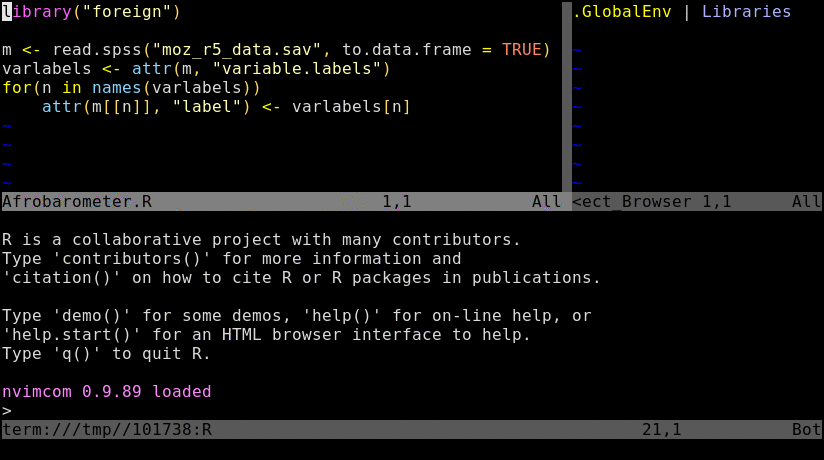This is the development code of Nvim-R which improves Vim's support to edit R scripts.
If you use a plugin manager, follow its instructions on how to install plugins
from GitHub. Users of lazy.nvim who
opted for defaults.lazy=true have to configure Nvim-R with lazy=false.
The stable branch is a copy of the last released version plus minor bug
fixes eventually found after the release.
James Eapen maintains an online version of the plugin's documentation. Please, read the section Installation for details.
Please read the plugin's documentation for instructions on usage.
The animated GIF below shows R running in a Neovim terminal buffer. We can note:
-
The editor has some code to load Afrobarometer data on Mozambique, R is running below the editor and the Object Browser is on the right side. On the R Console, we can see messages inform some packages were loaded. The messages are in magenta because they were colorized by the package colorout.
-
When the command
library("foreign")is sent to R, the string read.spss turns blue because it is immediately recognized as a loaded function (the Vim color scheme used is southernlights). -
When Mozambique's
data.frameis created, it is automatically displayed in the Object Browser. Messages about unrecognized types are in magenta because they were sent to stderr, and the line Warning messages is in red because colorout recognized it as a warning. -
When the "label" attributes are applied to the
data.frameelements, the labels show up in the Object Browser. -
The next images show results of omni completion.
-
The last slide shows the output of
summary.
The diagram below shows how the communication between Vim/Neovim and R works.

The black arrow represents all commands that you trigger in the editor and that you can see being pasted into R Console. There are three different ways of sending the commands to R Console:
-
When running R in a Neovim built-in terminal, the function
chansend()is used to send code to R Console. -
When running R in an external terminal emulator, Tmux is used to send commands to R Console.
-
On the Windows operating system, Nvim-R can send a message to R (nvimcom) which forwards the command to R Console.
The R package nvimcom includes the application nvimrserver which is never used by R itself, but is run as a Vim/Neovim's job. That is, the communication between the nvimrserver and Vim/Neovim is through the nvimrserver standard input and output (green arrows). The nvimrserver application runs a TCP server. When nvimcom is loaded, it immediately starts a TCP client that connects to nvimrserver (red arrows).
Some commands that you trigger are not pasted into R Console and do not output
anything in R Console; their results are seen in the editor itself. These are
the commands to do omnicompletion (of names of objects and function
arguments), start and manipulate the Object Browser (\ro, \r= and \r-),
call R help (\rh or :Rhelp), insert the output of an R command
(:Rinsert) and format selected text (:Rformat).
When new objects are created or new libraries are loaded, nvimcom sends messages that tell the editor to update the Object Browser, update the syntax highlight to include newly loaded libraries and open the PDF output after knitting an Rnoweb file and compiling the LaTeX result. Most of the information is transmitted through the TCP connection to the nvimrserver, but temporary files are used in a few cases.
-
cmp-nvim-r: nvim-cmp source using Nvim-R as backend.
-
languageserver: a language server for R.
-
colorout: a package to colorize R's output.
-
R-Vim-runtime: development version of some Vim runtime files for R.
